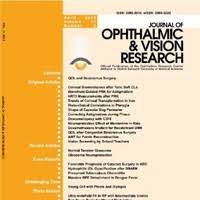Axial length to corneal radius of curvature ratio and refractive errors
Authors
Affiliations
1Noor Ophthalmology Research Center, Noor Eye Hospital, Tehran, Iran ; Farabi Eye Hospital, Tehran University of Medical Sciences, Tehran, Iran.
2Noor Ophthalmology Research Center, Noor Eye Hospital, Tehran, Iran.
3Shahroud University of Medical Sciences, Shahroud, Iran.
4Education Development Center, Tehran University of Medical Sciences, Tehran, Iran.
5Noor Ophthalmology Research Center, Noor Eye Hospital, Tehran, Iran ; Department of Optometry, Tehran University of Medical Sciences, Tehran, Iran.
6Department of Epidemiology and Biostatistics, School of Public Health, Tehran University of Medical Sciences, Tehran, Iran.
Abstract
Purpose:
To determine the distribution of axial length (AL) to corneal radius of curvature (CRC) ratio and to evaluate its association with refractive errors in an Iranian population.
Methods:
In this cross sectional study, multistage cluster sampling was used to select subjects 40-64 years of age residing in Shahroud, northern Iran. All subjects underwent manifest and cycloplegic refraction, and biometry using the Allegro Biograph (WaveLight AG, Erlangen, Germany). Individuals with a history of intraocular surgery, extensive pterygia and ocular trauma were excluded.
Results:
Of a total of 6,311 patients, 5190 (82.2%) participated in the study. We excluded 247 patients to adhere with study criteria and 132 patients due to missing data. Mean AL/CRC was 3.034 [95% confidence interval (CI), 3.031-3.037]. AL/CRC was 3.028 and 3.042 in female and male subjects, respectively (P<0.001). The R2 coefficients between spherical equivalent (SE) refractive error and AL/CRC, AL, CRC, lens thickness, and anterior chamber depth were 0.607, 0.351, 0.012, 0.038, and 0.091, respectively. Linear regression showed a 12.1 diopter (D) shift towards myopia with every 1 unit increase in AL/CRC (P<0.001). Mean AL/CRC was 3.472 among myopes with SE less than-5.0D; this value decreased linearly and was as low as 2.690 among hyperopes with SE more than 5.0D. R2 coefficients for AL/CRC with spherical and cylindrical power were 0.560 and 0.071, respectively.
Conclusions:
Minimal changes in AL/CRC lead to large changes in refractive error. The correlation between refractive errors was significantly stronger with the AL/CRC ratio than with AL and CRC alone.
Keywords: Axial Length, Corneal Radius of Curvature, Refractive Errors

